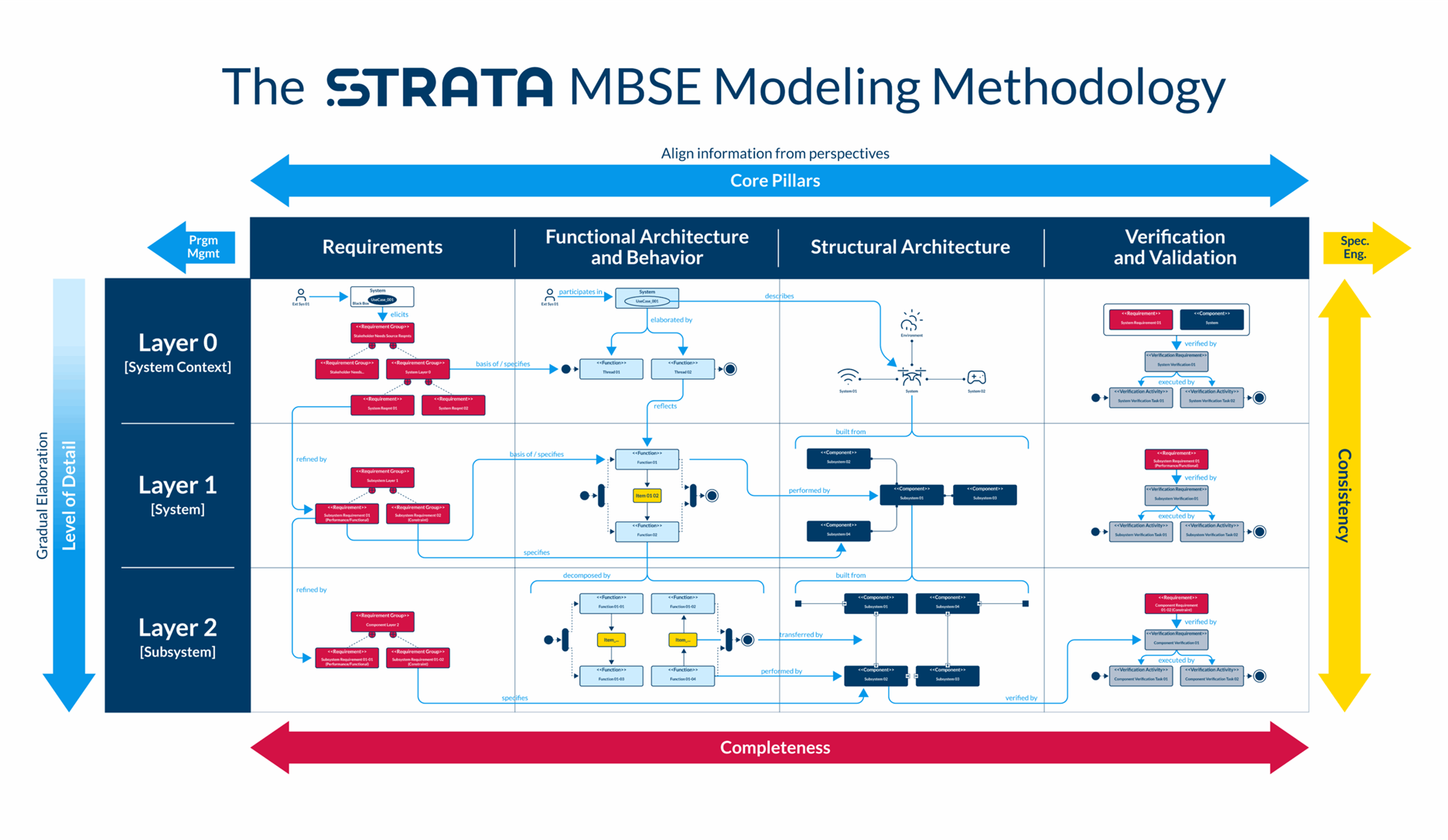
What Is a Modeling Methodology in MBSE?
In Model-Based Systems Engineering (MBSE), a modeling methodology is a structured framework that guides how modeling is applied throughout the system development lifecycle. It combines several essential elements to ensure consistency, clarity, and collaboration across teams:
- Processes: The logical sequence of tasks—what needs to be done (e.g., capturing requirements before defining verification strategies).
- Methods: How each task is performed, including modeling techniques and best practices.
- Tools and Languages: The instruments used to execute the methodology effectively, such as GENESYS and the Comprehensive Systems Design Language (CSDL).
- Modeling Guidelines: Rules and standards that promote consistency and quality in model creation (e.g., ensuring functions are properly allocated).
- Artifacts: The outputs of the modeling process, including diagrams, tables, and reports that document the system design.
- Roles and Responsibilities: Clear definitions of who does what—systems engineers, program managers, and other stakeholders.
- Integration with Other Disciplines: How MBSE connects with software, hardware, testing, and other engineering domains.
A well-implemented methodology ensures that everyone on the team is building the system model in a consistent way, aligned with shared goals and standards. Examples of MBSE methodologies include OOSEM, SYSMOD, MagicGrid, Harmony, , Arcadia, and Vitech’s STRATA methodology.
What is STRATA?
STRATA—short for Strategic Layers—is a model-based systems engineering (MBSE) methodology designed for use with GENESYS. It organizes model entities into layers of system abstraction and systems engineering process pillars, enabling teams to manage logical decomposition while preserving interconnections across hierarchical layers. Unlike traditional waterfall approaches, STRATA supports iterative refinement, allowing updates at lower levels to inform higher-level decisions. This flexibility empowers practitioners to begin modeling from any known concept, regardless of its position within the system structure. When paired with GENESYS and its built-in completeness and design integrity checkers, STRATA helps engineers build consistent, complete models, identify gaps or inconsistencies, and maintain a holistic view of the system throughout development.
What are the advantages of STRATA?
STRATA’s advantages shine most when systems engineers are navigating complexity, uncertainty, or evolving requirements. Whether you’re starting with partial information or managing a multi-domain system, STRATA provides the flexibility and structure needed to build robust, traceable models.
- Early-stage modeling: STRATA allows engineers to begin with any known concept, making it ideal when only fragments of the system are understood.
- Iterative development: Its support for refinement across abstraction layers ensures that updates at one level can inform and improve others.
- Multi-system integration: STRATA goes beyond the system-of-interest to include environmental and enterprise systems, supporting broader system-of-systems thinking.
- Full lifecycle alignment: It covers all ISO-15288 systems engineering processes, making it valuable throughout the entire development lifecycle.
- Traceability across perspectives: STRATA maintains connections between architectural decisions and derived requirements, helping teams manage change with confidence.
- Built-in quality checks: GENESYS’ completeness and integrity rules help identify gaps and inconsistencies early, reducing rework.
- Early verification & validation: STRATA prioritizes V&V from the start, ensuring the system meets requirements and performs as intended.
In short, STRATA is most advantageous when flexibility, traceability, and completeness are critical to delivering a successful systems engineering outcome.
STRATA Implementation: A Structured Approach to MBSE
STRATA organizes system modeling into a structured grid that combines two dimensions: perspectives (pillars) and levels of abstraction (layers). This grid defines modeling activities and artifacts within intersecting cells, allowing engineers to build models that are both comprehensive and scalable.
- The Pillars (Perspectives): STRATA aligns key system views—Requirements, Functional Architecture & Behavior, Structural Architecture, and Verification & Validation—within each layer. These perspectives reflect how requirements drive behavior, behavior maps to structure, and requirements are verified and validated. Additional pillars such as Program Management (e.g., WBS, risks, responsibilities) and Specialty Engineering (e.g., FMEA) extend the methodology to cover broader engineering concerns.
- The Layers (Levels of Detail): Each row in the STRATA grid represents a deeper level of system detail:
- Layer-0 models the system context—external interactions, originating requirements, and environmental conditions.
- Layer-1 describes the system as a whole—refining requirements, integrating behavior, and initiating physical decomposition.
- Layer-2 and beyond focus on subsystems—further refining requirements, decomposing behavior, and allocating functions to physical components.
This layered approach supports progressive elaboration, enabling engineers to trace design decisions across perspectives and abstraction levels. While STRATA can be explained top-down for clarity, in practice, modeling can begin from any cell—depending on available information. Whether starting with high-level requirements, existing physical components, or behavioral insights, STRATA provides a flexible yet disciplined framework for building complete, consistent, and validated system models.
Using STRATA in GENESYS with CSDL
The STRATA modeling methodology is optimized for Vitech’s GENESYS software, which is powered by the Comprehensive Systems Design Language (CSDL)—a modeling language built on the ERA model (Entities, Relationships, Attributes). CSDL unifies systems engineering concepts across domains, enabling intuitive yet semantically precise modeling. When combined with STRATA, CSDL’s relational structure allows seamless traversal between abstraction layers (rows) and systems engineering perspectives (pillars), reinforcing traceability, consistency, and completeness.
Implementing STRATA in GENESYS involves configuring the model to reflect your organization’s strategic layers and engineering pillars:
- Define Layers: Add a custom “layer” attribute to all entities and define layer names and designators using the Defined Term This creates a shared vocabulary for abstraction levels.
- Configure Packages and Folders: Organize model content by creating packages for each layer and optional subpackages for each pillar. Use folders to structure entities by layer within each major class.
- Use STRATA Pillar Facilities: Filter the Project Explorer to focus on relevant classes for each pillar, streamlining work within specific engineering perspectives.
- Build Consistency and Allocation Tables: Create metachain-based tables and matrices to visualize relationships across layers and pillars, helping identify gaps, orphan entities, and misallocations.
- Apply Visual Templates: Use STRATA Layer node templates in diagrams to clearly display layer designators and validate correct entity placement.
- Automate Organization: Run the STRATA Organization script to automatically sort entities into their designated layer-based folders and packages.
GENESYS also provides a rich set of purpose-built diagrams—such as Requirements, Use Case, Activity, and Sequence—that serve as effective STRATA artifacts, supporting both clarity and precision in model communication.




